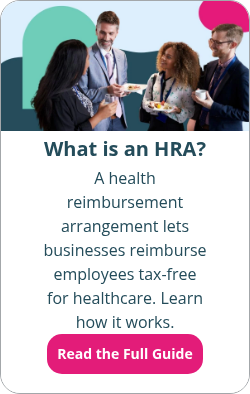HRAs for dummies
By Holly Bengfort on February 21, 2024 at 6:05 AM
Healthcare is often a complex and confusing topic, especially when it comes to navigating insurance plans and understanding the different options available to your organization. One such option that many business owners and HR professionals may not be aware of is a health reimbursement arrangement (HRA). HRAs have become increasingly popular in recent years as a way for employers to offer affordable healthcare benefits to their employees.
In this article, we'll break down the basics of HRAs and explain how they can benefit you and your employees.
Takeaways from this blog post:
- An HRA is an employer-funded health benefit that allows employers to reimburse employees for various qualified health expenses, including individual insurance premiums.
- Three of the most popular HRAs include the qualified small employer HRA (QSEHRA), individual coverage HRA (ICHRA), and group coverage HRA (GCHRA).
- HRAs offer accessibility, cost control, tax benefits, and flexibility. They can also improve employee retention and satisfaction.
What is an HRA?
A health reimbursement arrangement (HRA), sometimes mistakenly called a health reimbursement account, is an IRS-approved, employer-funded health benefit. With an HRA, employers can reimburse employees for more than 200 out-of-pocket expenses, including individual health insurance premiums, depending on the type of HRA you offer.
Here are a few examples of HRA-eligible expenses:
- Deductibles and co-pays
- Routine doctor visits and annual check-ups
- Prescription medications and over-the-counter items
- Dental expenses and vision expenses
- Chiropractic care
- Mental health counseling
Learn more about HRAs in our complete guide.
How are HRAs different from health savings accounts (HSAs)?
While HRAs and health savings accounts (HSAs) are both funded by pre-tax dollars, they have distinct differences.
HSAs are tax-advantaged health accounts for employees on HSA-qualified high deductible health plans (HDHPs). Employees can use them for qualified out-of-pocket medical costs like prescription drugs, over-the-counter medicine, dental expenses, and vision expenses. Employees generally can’t use HSAs for premiums.
Additionally, HRAs are employer-owned, while HSAs belong to employees. If an employee with an HSA leaves an organization, they take their HSA funds with them. If an employee with an HRA leaves an organization, the unused HRA funds stay with the employer, similar to a flexible spending account (FSA).
Learn more about the differences between an HRA and an HSA.
Where did HRAs come from?
From the 1960s to the 1990s, employers began offering reimbursement for medical expenses that health benefits plans didn’t cover. This happened as deductibles and exclusions became more common.
The IRS formally recognized HRAs in 2002 as an employer-funded health benefit for employees. This type of health coverage allows employers to reimburse employees, tax-free, for their healthcare expenses. Then, in 2014, the Affordable Care Act (ACA) prohibited individual health insurance from integrating with an HRA. This meant organizations could only offer integrated HRAs alongside a group plan.
In 2016, Congress created the QSEHRA, and the Departments of the Treasury, Labor, and Health and Human Services created the ICHRA in 2019. Eligible reimbursements can include individual health insurance premiums, out-of-pocket medical expenses, or a combination of the two.
Learn more about the history of HRAs.
How does an HRA work?
While each HRA is different, all HRAs allow employers to choose a monthly or annual allowance amount for reimbursement. Employees can then use these funds to pay for eligible medical care expenses throughout the year. This amount can vary depending on factors such as employee class, age, or family size.
Employer contributions are tax-deductible and payroll tax-free. The money employees receive is also free of income taxes as long as they have a health plan that provides minimum essential coverage (MEC).
While each HRA is different, all HRAs follow the same five-step structure:
- The employer sets an allowance amount that fits their budget.
- The employee makes healthcare purchases using their own money.
- The employee submits proof of their expense to their employer or HRA administrator.
- The employer reviews the expense to confirm it's eligible for reimbursement and has the required documentation.
- The employer reimburses the employee up to their set allowance amount.
Learn more about how HRAs work.
What are the different types of HRAs?
There are different types of HRAs available, each with its own set of rules and benefits.
The most common HRA types include:
- The qualified small employer HRA (QSEHRA): QSEHRAs are designed for small businesses with fewer than 50 full-time equivalent employees (FTEs). It allows for tax-free reimbursement of health insurance premiums and qualified medical expenses. The QSEHRA has an annual limit on employer contributions.
- The individual coverage HRA (ICRHA): ICRHAs work for employers of all sizes. They can offer an ICHRA as a standalone benefit or as an alternative health benefit to employee classes that don't qualify for the current group health insurance plan. Employers can also offer different allowance amounts to different employee classes. The ICHRA has no annual contribution limits. Employees must have individual health insurance to participate.
- The group coverage HRA (GCHRA): GCHRAs, also called integrated HRAs, work alongside traditional group health insurance plans. This type of HRA is often paired with a high deductible health plan (HDHP) to help cover health expenses that fall within the deductible. There's no annual contribution limit with a GCHRA.
- Excepted benefit HRA (EBHRA): EBHRAs allow employers to reimburse employees for excepted benefits only, such as dental or vision expenses. Like a QSEHRA, the IRS sets annual maximum contribution limits.
- The retiree-only HRA: The retiree HRA is only available to an organization’s retired workers. Organizations of all sizes can offer it, and it has no allowance caps or group health insurance requirements.
Learn more about the different types of HRAs.
What are the benefits of HRAs?
HRAs offer several benefits for both employers and employees.
Accessibility
An employer-funded group health plan may not always be the most suitable choice for many employers due to its complexities, fluctuating costs, and stringent requirements. However, an HRA provides a more accessible alternative. They don't have annual rate hikes or minimum participation requirements.
Cost control
With an HRA, employers can easily establish a custom allowance that employees can utilize towards any qualified medical expense of their preference. By setting a specific amount for each employee's HRA, employers can better control the cost of healthcare benefits. This is especially beneficial for smaller businesses with limited budgets. Plus, any unused funds stay with the employer.
Tax benefits
Contributions made by employers to HRAs are tax-deductible, and reimbursements to employees are tax-free as long as they have MEC. This can provide significant savings for both employers and employees.
Flexibility
HRAs provide more flexibility than traditional group health insurance. Instead of forcing employees into a generic, one-size-fits-all health plan, they can customize their healthcare coverage with an HRA. They can also use their HRA funds for a wide range of qualified expenses, giving them the freedom to choose the healthcare services that best meet their needs.
Employee retention and satisfaction
Offering an HRA as part of a comprehensive benefits package can help to attract and retain top talent. Findings from PeopleKeep's 2022 Employee Benefits Survey Report show that 87% of employees value health benefits, such as health insurance. Employees appreciate the additional financial support for healthcare expenses and feel valued by their employer.
Additionally, we found that 65% of employees surveyed value choosing their own benefits. Yet, only 36% of respondents felt they had a say in their benefits. With an HRA, it's easy to give employees the individuality they deserve.
Learn more about the benefits of HRAs
How do you manage an HRA?
While it's possible to manage an HRA on your own, why add more to your plate? You're better off using an HRA administrator that can save you valuable time and money.
When you offer an HRA through PeopleKeep, our intuitive and user-friendly software makes providing more accessible employee benefits easier for your organization. We handle the day-to-day benefits administration tasks, including compliance functions, documentation storage, and employee reimbursement verification. Plus, our award-winning customer support team is there to help every step of the way.
Learn more about offering an HRA through PeopleKeep
Conclusion
Whether you're an employer or a small business owner, an HRA is a smart choice for your team. HRAs are a valuable healthcare benefit option that can provide cost savings and flexibility for both employers and employees. By understanding the basics of HRAs, you can make informed decisions about healthcare benefits and ensure that you and your team have access to necessary care.
This blog post was originally published on May 21, 2019. It was last updated on February 20, 2024.
Check out more resources
See these related articles

Health insurance reimbursements: What are the options?
Explore your options for health insurance reimbursement. Understand what insurance reimbursement means and how HRAs can support employees.

What is healthcare reimbursement?
Looking to reimburse your employees for their healthcare expenses? Learn everything you need to know about healthcare reimbursement.

How HRAs work for spouses and dependents
Learn about the eligibility and benefits of health reimbursement arrangements (HRAs) for spouses and dependents in this comprehensive overview.



